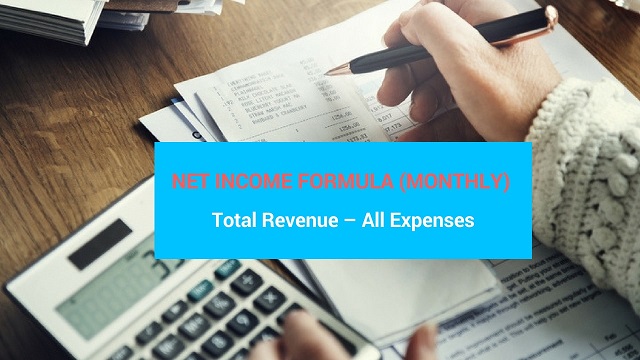Gross Income vs. Net Income: How Exactly Are They Different?
Businesses must make money.
Employees rely on a decent salary to cover life’s expenses.
Do the revenues generated by the business or the salary earned by an employee support a sustainable existence?
The answer depends on how much of the revenue reflects an actual profit. Do you know how to figure out actual profits?
Gross and net revenue aren’t the same things.
Revenues and Profits: The Difference
A business cannot point solely to revenue as a sign of success. Even if a business generated $1 million in revenues per year, calling the revenue figures laudable could be premature.
Why so?
A business spending $1.3 million to earn $1 million hardly embodies success. The business clearly loses $300,000 per year — an unsustainable figure.
Before entering into any type of business venture, understand the difference between gross income and net income.
Otherwise, a business owner or entrepreneur finds him/herself starting out with a skewed financial perspective.
Not understanding gross income versus net income won’t exactly help the cause of maintaining fiscal solvency. Targeting a preferred and necessary profit margin also becomes difficult.
Gross Income Explained

A basic gross income definition can be simply described as revenue prior to deductions. Consider the following example:
A grocery store owner sells a variety of products. When someone purchases $100 worth of groceries, the $100 reflects the gross amount of the sale.
No other costs factor into the gross figure.
Similarly, someone who works as a salaried employee may earn $1,000 per week. This is salary the employer agrees to pay. The actual paycheck won’t be the same amount due to deductions.
Now, an independent contractor may receive the full $1,000 per week. On the surface, this may seem like gross profit but it really isn’t.
Once April 15th arrives, taxes become due on the money earned during the year.
The deductions normally taken out of a paycheck by an employer must be paid by the self-employed independent contractor. Hopefully, the independent contractor paid his or her estimated quarterly taxes during the year.
The Net Form of Income Explained

To understand a basic net income definition, look the costs necessary to turn a profit. Also, examine what other expenses/deductions factor into earnings and revenue.
With a salaried employee, a paycheck comes with common deductions. Federal income taxes and payroll taxes affect net profit.
Payroll taxes refer to social security and medicare deductions. These might not be the only deductions taken out of a paycheck. State and city taxes may be levied as well.
As for business owners, returning to the example of a grocery store further fleshes out the difference between the gross income definition and net income definition.
If a can of soup costs 30 cents and the can of soup sells for $1, the seemingly gross profit on the can of soup would be 70 cents.
This isn’t entirely correct though.
Taxes must be paid on the income generated from the sale.
So, if 20% in taxes becomes levied against the 70, then the remaining net would be 56 cents. Other expenses may include delivery and various overhead expenses. Overhead comes in the form of rent, electricity, security systems, and more.
Figuring Out a Gross Income Formula

A basic gross income formula presents a clear picture of what a business or employee earns. In general, a gross income formula won’t be too complicated to follow.
The key step here involves tallying all revenue and/or salary figures up for the entire year. Each and every revenue source must be accounted for or else the gross figure lacks accuracy.
Formulas for gross income often reflect monthly figures. Even when using your annual figure as the baseline gross amount, the formula won’t be too difficult to ascertain.
Simply divide an annual salary by 12. 12, of course, reflects the number of months in the year.
So, gross monthly income equals annual income divided by 12.
A person earning $60,000 per year would use the following formula: $60,000 / 12 = $5,000.
$5,000 reflects the gross monthly amount.
A business owner or independent contractor earning the $60,000 per year uses the same formula. Consequently, he/she arrives at the same figure.
When an employee earns an hourly salary, the formula changes a bit. The required formula remains simple though. An hourly employee must take his/her hourly pay and multiply it by the number of hours worked per week.
Then, the figure must be multiplied by the number of weeks worked per year.
So, the formula looks like this for someone working full-time at $10 per hour: $10 x 40 hrs per week x 52 weeks per year.
The formula leads to a dollar amount of $20,800.
To find the monthly income’s gross figure, the annual figure must be divided by 12.
Here is the complete formula: ($10 x 40 hrs per week x 52 weeks per year) / 12 = $1,733.33.
The Net Income Formula Approach

The gross income formula isn’t alone. A net income formula can be tapped to figure out net dollar amounts. The net income formula also relies on simple, basic math to arrive at the appropriate numbers.
Once again, expenses must be deducted in order to arrive at a net figure. Weave all necessary expenses into any equation attempting to arrive at net revenue amounts.
As always, don’t look for a complicated formula. This can raise the complexities as well the temperature in your head.
The most basic net formula looks like this: Total Revenue – All Expenses = Net Income.
So, $50,000 in revenue minus $20,000 in expenses yields a net of $30,000.
Whether that $30,000 is good or bad all depends on whether the amount can cover living expenses. Figuring out lifestyle expenses, however, requires examining a separate formula.
Net Income vs Net Profit Figures

An important distinction must be made regarding net income vs net profit figures.
Knowing the difference between these two is just as important as knowing the difference between gross income versus net income. Ultimately, a business owner, independent contractor, and even a salaried employee must know how much money he/she ultimate gets to keep.
This way, the individual can rely on an accurate figure to determine how much money is available to cover living expenses, emergencies, and for short or long-term savings.
With the income net figure, a person or business looks at how much income is present after expenses.
Again, earning, say, $50,000 in revenue minus $20,000 in expenses leads an income net of $30,000.
That $30,000, however, doesn’t entirely belong to the person or business that earned it. Tax obligations come into play, too. After subtracting the tax obligations, the net profit figure reveals itself.
For an independent contractor or another sole proprietor, the profit formula may look something like this: Income – (Self-employment tax + income tax + state tax).
Be mindful of other taxes to include in the figure such as city tax, use tax, or occupancy tax. Not all taxes involve income taxes.
All this might seem a little difficult to figure out. Anyone trying to arrive at figures in his/her head might become confused. Writing out equations longhand can be a bit tough. A better plan involves looking at a decent calculator to determine net and gross figures.
Relying on a Calculator
To cut down on the chances of making a mistake and increasing the ability to see accurate figures, use both a gross income calculator and a net income calculator to determine exact figures.
Searching for one or both of these calculators won’t be too difficult. Several different online resources make the calculators available via flash programming. With flash calculators, users won’t need to download software. The calculators appear right on a website. Users can insert figures into appropriate boxes on the virtual calculator.
Certain calculators already access information based on the state where the user lives. For example, selecting the state of New York allows the calculator to figure out applicable state taxes.
With a gross income calculator, information such as gross salary year-to-date, net pay, federal withholdings, and any tax exemptions could be factored into the calculation. Net income calculators would present similar applicable figures.
Different calculators may be more expansive than others. Some might come with a better layout. Be sure to pick the one that delivers the best calculations through a user-friendly design. Using a calculator shouldn’t be a taxing exercise.
Of course, the user also must do his/her part. Take great care when typing in the figures. Typos could lead to skewed results on the gross and net income equation figures. Try to avoid guessing on any dollar amounts. The calculations deliver the best value when they are completely accurate ones.
Real Estate and The Multiplier

Investments should also factor into any calculations regarding net and gross figures. Investments reflect personal assets and net worth. Anyone interested in a complete and broad picture of his/her financial well-being benefits from examining costs and profits associated with investment endeavors.
And this doesn’t refer solely to stocks, bonds, money markets, and other liquid assets. Real estate must not be overlooked. After all, most draw the bulk of their net worth from real estate holding and assets. Therefore, homeowners benefit by ascertaining the gross income multiplier.
What is the figure’s exact purpose?
The gross income multiplier (GIM) serves as a way to appraise the value of a property. GIM does so through utilizing a simple formula relying on two different pieces of data: gross — not net — income and the property’s value.
Annual income, in this case, refers to the revenue generated by the property. Rent, for example, would be the most common example of how a property earns income. Running a home-based personal training business reflects another example.
The formula itself takes the form of property value divided by annual income. So, if a home is worth $200,000 and the property generates $25,000, the formula would be $200,000 / $25,000 = 8.
8 represents the GIM.
Keep in mind, taxes and other expenses won’t be deducted from the overall annual revenue figure. Figures can be broken down further by factoring in all the expenses. Do so to determine whether the tasks to draw in annual revenue are truly worth the effort.
Examine the costs associated with running a business to better determine if selling the property makes a sound — and wiser — financial decision.
Not everyone, however, finds him/herself in a position to sell a property. So, examining the costs via a gross and net income calculator may assist with better budgeting approaches for generating income from a home or commercial property.
Knowing Where You Fiscally Stand
Why invest so much time figuring out the gross and net income equation figures? A better understanding of a financial situation helps with making smart decisions. Informed decisions usually turn out to be the best decisions.
Limited perspectives on net worth, annual revenue, and available assets undermine decision making. A complete and proper perspective definitely supports making better decisions.





